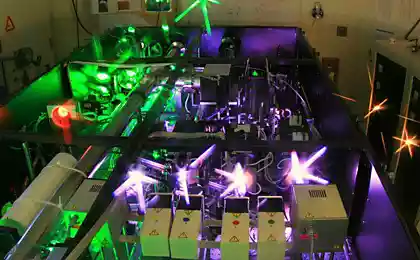641
The laser was first filmed on camera

Researchers first able to videotape the laser is reflected from the mirror.
Watch how colorful fly past the line of light, it is extremely exciting in any SF movie, but in reality to observe the laser beam is not easy. In order to view it, photons from the laser must get on the retina, and due to the fact that the laser is a coherent stream moving in one direction, it only happens when the laser beam falls on something that reflects part of the world.
Insignificantly small number of photons reflected from the air molecules are located in, but not enough to see the beam. You can fix this by unleashing smoke to give the laser more molecules of which it will be displayed, but it is not the same effect as in the movies.
"The challenge was to create a video of the laser beam moving through the clear air" - says Geneva Gariepi from Heriot-Watt in Edinburgh. - "We wanted to look at the light does not interact with it, just as it flies past.»
To achieve this, the researchers constructed a highly sensitive enough to capture these individual reflected from the individual atoms of photons. It is built of cells sensors located 32 x 32, and records the time of detection of a photon with an accuracy equivalent to shooting at a rate of 20 billion frames per second.
Scientists placed the entire system for recording the side of the laser lights of a system of several mirrors. Produced two million pulses for 10 minutes and subtracting from the result of background noise, they were able to collect enough photons reflected from the air to track all the way reflected beam.
"At the output we get the single-frame of the beam through our system" - says Gariepi. In the video data on the position of the beam superimposed on the picture taken a regular camera, and painted green to match the color of the laser.
The experiment began as a research puzzle, but Gariepi believes that the results can be of practical use. In another experiment was filmed focused laser that ionized atoms of air to create plasma. Gariepi says that such experiments could help in the study of plasma, allowing her to see changes in supershort time intervals.
Source: geektimes.ru/post/245008/
How will the launch of the heavy carrier rocket Falcon Heavy?
Case for smartphone instant photo prints






















